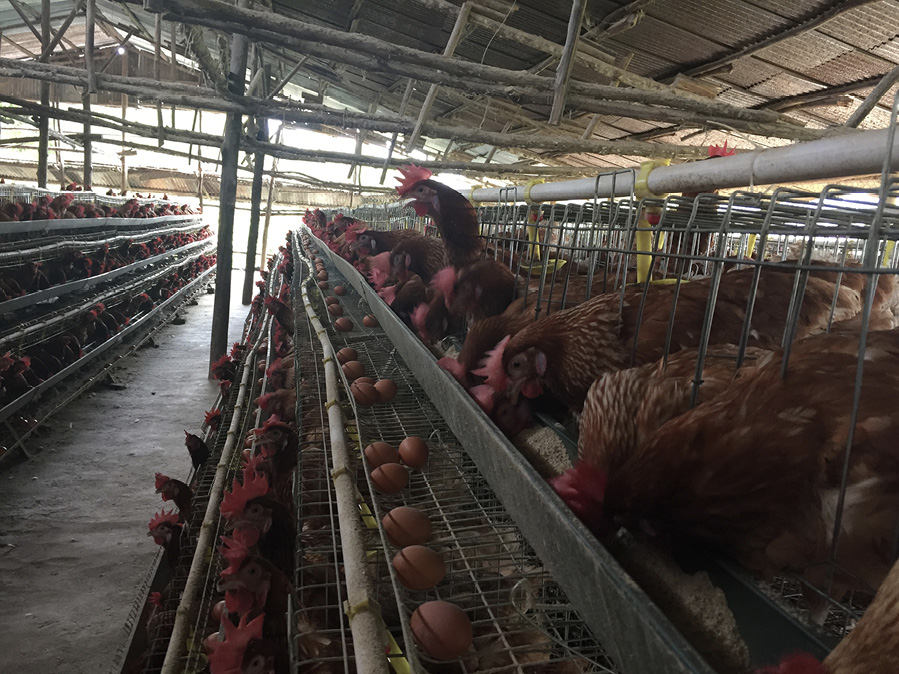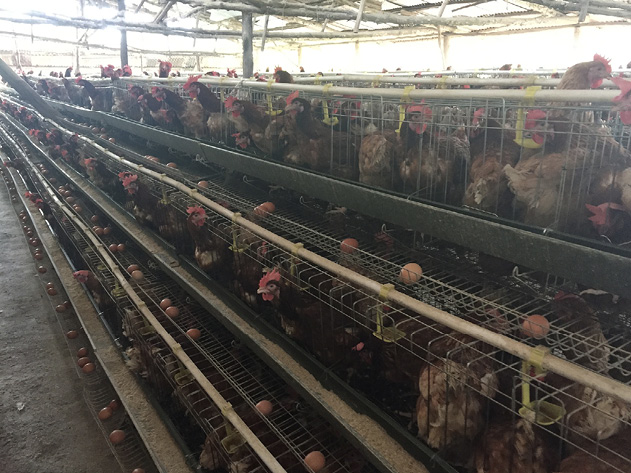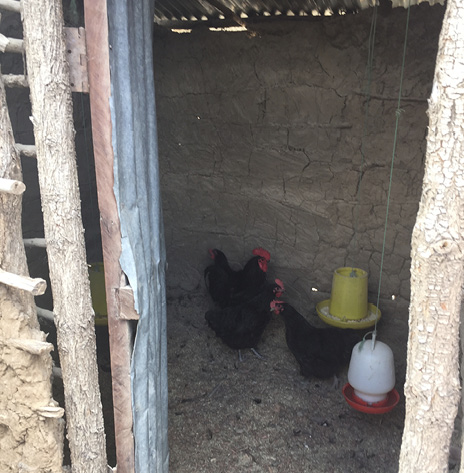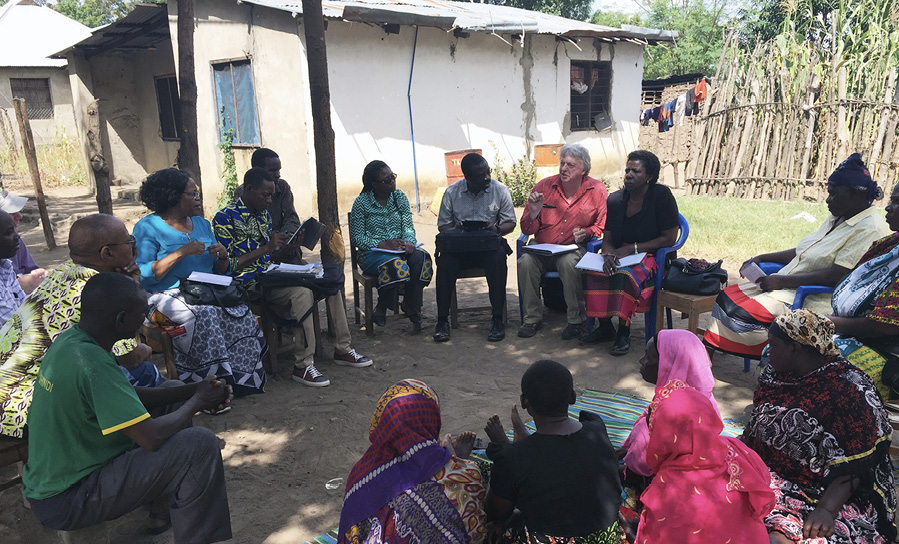Poultry Production in Africa: Impacts of Climate Change
Global Climate Change
The global human population is expected to increase to 9.6 billion by 2050 (UN, 2013). More than 1 billion of this increase will occur in Africa (Thornton et al., 2009). Continuing urbanization in developing countries, along with population growth and rising incomes, is fueling a global demand for livestock products that will significantly increase in the coming decades (Delgado et al., 1999). The demand for agricultural products will increase by about 70 percent as the global standard of living increases during this period (FAO, 2009).
To feed the projected global population, we will have to produce more food on the land we currently have. However, intensive farming practices can damage land and ecosystems. The trend of consuming more animal products negatively impacts ecosystems and water sources, particularly in developing countries. Water pollution can result from antibiotic use, animal excreta, fertilizers and pesticides used in forage production, and runoff from pastures (Steinfeld et al., 2006).
Climate change is defined as deviations in patterns of climate over a long period of time (Ngaira, 2007). Global climate change is primarily caused by GHG emissions that result in warming of the atmosphere (IPCC, 2013). The livestock sector contributes 14.5 percent of global GHG emissions (Gerber et al., 2013) and, therefore, plays a significant role in increasing land degradation, air and water pollution, and decreased biodiversity (Bellarby et al., 2013; Reynolds et al., 2010; Steinfeld et al., 2006, Thornton and Gerber, 2010). It is vital that we find ways to reduce waste and GHG emissions while accommodating future growth in livestock production (Gerber et al., 2013).
Climate change poses a threat to agricultural and socioeconomic development (Niang et al., 2014). It affects livestock production through competition for natural resources (particularly water), quantity and quality of feeds and forage, heat stress, livestock diseases and pests, and biodiversity loss at a time when demand for livestock products is expected to increase by 100 percent by the mid-21st century (Garnett, 2009). The challenge is maintaining a balance between productivity, food security, and environmental preservation (Wright et al., 2012).
The livestock sector was initially viewed as a victim of climate change until it was implicated as a contributor to global GHG emissions such as carbon dioxide (CO2), methane (CH4), and nitrous oxide (N2O) (Abioja and Abiona, 2020). Methane, mainly produced by enteric fermentation and manure storage, is a gas that affects global warming 28 times greater than carbon dioxide. Nitrous oxide, arising from manure storage and use of organic/inorganic fertilizers, has a global warming potential 265 times higher than carbon dioxide (Grossi et al., 2019). These gases increase global warming by trapping heat at the earth’s surface and not allowing it to escape into space.
Impact of Climate Change in Africa
The livestock sector contributes to the livelihoods of 1 billion of the most impoverished people in the world and employs close to 1.1 billion people (Hurst et al., 2005). Across Africa, hundreds of millions of pastoralists and smallholders depend on livestock for their daily survival, extra income, and food, making efforts aimed at environmental protection more challenging (Gerber et al., 2013).
Africa is the most affected continent by predicted effects of climate change, although it emits the least GHGs (Ngaira, 2007; Abioja and Abiona, 2020). A predicted rise in temperature of 2–6°C is expected over Africa within the next 100 years, with a rise of 1.5–3.0°C by 2050, which is more severe than other regions (Abioja and Abiona, 2020).
A warmer climate will adversely affect food security in Africa, disrupting natural ecosystems (Ngaira, 2007). Grasslands and deserts will expand, coastal regions will be submerged, and most perennial rivers flowing through deserts likely will dry up, inhibiting irrigation and increasing famine and starvation. For example, Egypt is 96 percent desert and 97 percent of the population is concentrated on only 4 percent of irrigated land (Jackson, 1989). If the Nile waters used for irrigation dry up, there will be no food, and the people of Egypt will migrate to other, more habitable regions in temperate lands (Ngaira, 2007).
Agriculture across much of sub-Saharan Africa is expected to be among the hardest hit sectors by climate change (Mendelsohn and Massetti, 2017; Parry et al, 2004). Climate impacts will have a more devastating effect in arid and semi-arid regions where increased drought frequencies are expected to reduce vegetation cover and livestock numbers, and higher temperatures will cause an increase in demand for scarce water resources (Ayanlade et al., 2017; Debela et al., 2015; Ou and Mendelsohn, 2017; Thornton et al., 2009).
Impacts of Climate Change on African Poultry Production
Flock heat stress associated with climate change is a severe challenge to poultry farmers because of its negative effect on chicken growth and productivity (Liverpool-Tasie et al., 2019). Poultry farmers across Africa are aware of climate change because many of them are dealing with changes in rainfall amounts and patterns, heat waves, and variability in other climatic elements. These farmers have used indigenous knowledge in adapting to these changes, especially high environmental temperatures (Abioja and Abiona, 2020).
Poultry production decreases at temperatures higher than 30°C (Ensminger et al., 1990). Heat stress on poultry reduces feed intake, weight gain, carcass weight, and protein/muscle calorie content (Tankson et al., 2001). Furthermore, heat stress on hens reduces reproductive efficiency and, consequently, egg production (Figure 1) because of reduced feed intake and interrupted ovulation (Nardone et al., 2010; Novero et al., 1991). Egg weight and shell thickness may also be negatively affected by increasing temperatures (Mashaly et al., 2004).

Poultry and other livestock farmers are currently experiencing the adverse effects of climate change. Previous studies have demonstrated that pastoralists and livestock producers across Africa have associated changes in temperature and rainfall patterns with reduced feed resources, greater animal mortality rates, smaller herd sizes, fewer water sources during the dry season, decreased animal performance and productivity, and emergence of new animal diseases (Ayanlade et al., 2017; Debela et al., 2015; Silvestri et al., 2012; Zampaligré et al., 2014).
Africa has two main poultry production systems: commercial poultry (intensive; Figure 2) and village poultry (extensive; Figure 3). Commercial poultry is on a medium to large scale and utilizes improved genetics and exotic breeds raised intensively in facilities that can provide for the feeding, health, protection, and welfare of birds on a large scale with relatively high returns. Village (also known as rural, backyard, or extensive) poultry, on the other hand, is on a much smaller scale utilizing indigenous breeds of birds with lower productivity. An intermediate production system on a scale somewhere between the commercial and village level has developed over time.


Village poultry is a much older production system and much more widespread than commercial poultry, which is relatively new to Africa. Efforts to genetically improve commercial broiler chickens have been ongoing in the U.S. since the 1940s. Exporting improved chicken genetic strains into African countries began in the 1950s, coinciding with development of commercial poultry systems in Africa (Abioja and Abiona, 2020).
All poultry production systems are threatened by impacts of climate change, which can be divided into direct and indirect impacts. Increased temperature and heat stress have been linked to poultry death losses, loss of quality and quantity of egg production, and reduced growth rates in intensive production systems elsewhere (Bhadauria et al., 2014; Gous, 2010; Gregory, 2010).
Direct Impacts
Climate change can impact poultry production by stressing the birds’ ability to maintain homeostasis. To some extent, poultry can adapt to a hot environment. However, in extreme climatic conditions (high temperature and humidity, water scarcity, etc.), birds must work to regulate their temperature and, therefore, lose and divert nutrients that should be used for production. This leads to production losses (reduced growth rate, lower egg production, increased disease threat, and higher mortality) in poultry (Attia et al., 2011). Increasing temperature is likely the greatest climate change factor affecting poultry.
Changes in humidity compound the effects of high environmental temperature. Birds reduce their feed consumption in a hot environment to limit metabolic heat production. High humidity makes it increasingly difficult for birds to cool themselves and evaporate water off their respiratory systems. Laying hens respond to increasing temperatures by reducing the number and size of eggs produced. Stressful weather conditions negatively affect internal and external quality of eggs. High temperatures result in lower fertility rates, egg hatchability, and chick quality. Additionally, heat-stressed males produce semen with lower sperm quality and concentration (Karaca et al., 2002).
Indirect Impacts
African poultry production is also at risk of indirect climate change aspects that will impact feed ingredient availability and quality for poultry, particularly for the commercial poultry industry. Arid and semi-arid regions experiencing increasing temperatures, low rainfall, and irregular rainfall patterns cannot produce the bountiful harvests needed to stave off rising feed prices. Climate change is predicted to decrease crop productivity and increase market prices and malnutrition in sub-Saharan Africa (Thompson et al., 2010).
Poultry feed and water intake are closely related. If water intake is restricted, feed intake and growth rate will also be reduced. Plenty of clean, good-quality water must always be available if birds are to have any chance of reaching their genetic potential. Unfortunately, climate change is resulting in reduced water in ponds, rivers, streams, and seas immediately after the rainy season across Africa because of an increased rate of evaporation (Alemayehu and Woldeamlak, 2017).
Strategies to Reduce Climate Change Impacts on African Poultry Production
The poultry industry has a natural advantage over other livestock industries because of its low global warming potential (Costa, 2009). Chickens emit no methane and emit less phosphate and carbon dioxide than other meat-producing animals (FAO, 2010). In addition, chicken is usually the least expensive of all domestic livestock meats, particularly for sub-Saharan African and South Asian countries (FAO, 2010). Poultry meat and egg production is the most environmentally efficient animal protein production system (Mengesha, 2011).
Despite efforts to develop intensive poultry production systems, village poultry remains vitally important in developing countries across Africa (Gueye, 2009). Commercial broiler chickens (both males and females) are used for meat production only, although males grow faster than their female counterparts. Most strains of broilers currently raised in Africa are developed in more temperate regions of the world such as the U.S. and the Netherlands and imported into Africa. Unfortunately, heat stress associated with climate change makes these birds incapable of reaching their inherent growth potential, and productivity in Africa is often below what is achievable in cooler climates (Abioja and Abiona, 2020).
Farm animals in tropical regions suffer from heat stress at one time or another because of constant elevated ambient temperatures (Altan et al., 2000). Fast-growing broiler chickens are susceptible to heat stress mainly during the growing-finishing stage. As they age, metabolic heat production increases in response to high feed intake and a fast growth rate. However, their ability to dissipate heat does not increase, making them susceptible to hyperthermia (increased core body temperature), which can be life-threatening when ambient temperatures are above the thermoneutral zone.
In Nigeria, poultry farmers should follow a set of adaptation strategies to climate change in response to heat stress (Liverpool-Tasie et al., 2019). These include:
- improving air ventilation
- improving water ventilation
- engaging in fish farming to lessen the risk
- spreading litter and de-caking chicken houses
- using energy-efficient lamps for lighting (these create less heat)
- using vitamins and medications for birds
These novel strategies were developed in response to intensive poultry production, and farm size (commercial, intermediate, or backyard) played a role in what strategies were adopted at what farm-size level. These strategies are in addition to the more traditional strategies of early stocking, changing litter frequently, and keeping local, indigenous breeds, a practice that is more common with village poultry production.
For poultry farmers to take advantage of emerging opportunities, two areas that must improve are poultry production training (Figure 4) and financial recordkeeping. Currently, training and record keeping are largely practiced only by medium- and large-scale farms (Liverpool-Tasie et al., 2019). Only 10 percent of small farms keep financial records, compared to 55 and 79 percent of medium- and large-scale farms, respectively. While about 30 percent of medium and large farms reported having received some level of training on poultry production, only 4 percent of small farms did. A key difference between medium and large farms is that the latter tend to have more access to private training (22 percent compared to 10 percent for medium farms). This indicates that the poultry sector is fueling an increased demand for Extension programming and training (Liverpool-Tasie et al., 2019).
The U.S. poultry model offers many possibilities for Africa. The U.S. poultry industry is one of the most efficient systems in the world with the lowest environmental impact. Best management practices, research, and technology that make this possible can be shared with other livestock production regions around the world, particularly Africa. Even though all regions have unique demands and abilities, and will require unique regional solutions, advances in the U.S. agriculture and food system can be adapted within these regional solutions to benefit much of Africa (Mitloehner, 2016).

Summary
Climate change will affect livestock and poultry production across Africa and, consequently, food security throughout the region. Agriculture plays a critical role in global environmental issues such as biodiversity loss, water pollution, land degradation, and climate change. Knowing this, we must determine how best to maintain a balance between productivity, food security, and environmental preservation. Climate change impacts will have a more devastating effect in arid and semi-arid regions where increased drought frequencies are expected to reduce vegetation cover and livestock numbers, and higher temperatures will cause an increase in the demand for scarce water resources.
Studies have demonstrated that livestock producers across Africa have noted that changes in temperature and rainfall patterns result in reduced feed resources, greater animal mortality rates, smaller herd sizes, fewer water sources during the dry season, decreased animal performance and productivity, and emergence of new animal diseases. Poultry production across Africa is affected by climate change both directly and indirectly. However, it is possible to adapt the U.S. poultry model to Africa, thereby helping the continent to sustainably address the 2050 challenge of supplying food to a rapidly increasing human population.
References
Abioja, M. O., and J. A. Abiona. 2020. Impacts of climate change to poultry production in Africa: Adaptation options for broiler chickens. In: W. Leal Filho et al. (eds), African Handbook of Climate Change Adaptation. Springer Nature Switzerland.
Alemayehu, A., and B. Woldeamlak. 2017. Smallholder farmers’ coping and adaptation strategies to climate change and variability in the central highlands of Ethiopia. Local Environ 22(7):825–839.
Altan, O., A. Altan, I. Oguz, A. Pabuccuoglu, and S. Konyalioglu. 2000. Effects of heat stress on growth, some blood variables and lipid oxidation in broilers exposed to high temperature at an early age. Br Poult Sci 41(4):489–493.
Attia, Y. A., R. A. Hassan, A. E. Tag El-Din, and B. M. Abou-Shehema. 2011. Effect of ascorbic acid or increasing metabolizable energy level with or without supplementation of some essential amino acids on productive and physiological traits of slow-growing chicks exposed to chronic heat stress. J Anim Physiol Anim Nutr 95:744–755.
Ayanlade A., M. Radeny, and J. F. Morton. 2017. Comparing smallholder farmers’ perception of climate change with meteorological data: A case study from southwestern Nigeria. Weather Climate Extremes 15:24–33.
Bellarby, J., R. Tirado, A. Leip, F. Weiss, J. P. Lesschen, and P. Smith. 2013. Livestock greenhouse gas emissions and mitigation potential in Europe. Glob. Change Biol. 19:3–18.
Bhadauria P, J. Kataria, S. Majumdar, S. Bhanja, K. G. Divya, and G. Kolluri. 2014. Impact of hot climate on poultry production system: A review. J Poult Sci Tech 2(4):56–63.
Costa, N. D. 2009. Climate change: Implications for water utilization in animal agriculture and poultry, in particular. Proc. 20th Ann. Poult. Sci. Symp. Univ. of Sidney, Australia. Feb. 9–11.
Debela N., C. Mohammed, K. Bridle, R. Corkrey, and D. McNeil. 2015. Perception of climate change and its impact by smallholders in pastoral/agropastoral systems of Borana, South Ethiopia. SpringerPlus 4:236.
Delgado, C., M. Rosegrant, H. Steinfeld, S. Ehui, and C. Courbois. 1999. Livestock to 2020: The next food revolution. Food, Agriculture, and the Environment Discussion Paper 28. IFPR/FAO/ILRI, Washington, D.C.
Ensminger, M. E., J. E. Oldfield, and W. W. Heinemann. 1990. Feeds and Nutrition: Formerly, Feeds and Nutrition, Complete (second ed.), Ensminger Publishing Company, Clovis, CA.
FAO (Food and Agriculture Organization of the United Nations). 2009. Global agriculture towards 2050. High Level Expert Forum Issues Paper. FAO, Rome.
FAO (Food and Agriculture Organization of the United Nations). 2010. The state of food and agriculture 2009: Livestock in the balance. FAO. Rome.
Garnett, T. 2009. Livestock-related greenhouse gas emissions: Impacts and options for policymakers. Environ. Sci. Policy 12:491–503.
Gerber, P. J., H. Steinfeld, B. Henderson, et al. 2013. Tackling climate change through livestock: A global assessment of emissions and mitigation opportunities. FAO. Rome.
Gous, R. 2010. Nutritional limitations on growth and development in poultry. Livest Sci. 130:25–32.
Gregory N. 2010. How climatic changes could affect meat quality. Food Res Int. 43:1866–1873.
Grossi, G., P. Goglio, A. Vitali, and A. G. Williams. 2019. Livestock and climate change: Impact of livestock on climate and mitigation strategies. Anim. Front. 9(1):69–76.
Gueye, E. F. 2009. The role of networks in information dissemination to family poultry farmers. World’s Poult Sci. J. 65:115–124.
Hurst, P., P. Termine, and M. Karl. 2005. Agricultural workers and their contribution to sustainable agriculture and rural development. FAO, Rome. Available at: http://www.fao.org/tempref/docrep/fao/008/af164e/af164e00.pdf. Accessed: 7 February 2021.
IPCC (Intergovernmental Panel on Climate Change). 2013. Climate change 2013: The physical science basis. In: Stocker, T. F., D. Qin, G. K. Plattner, et al. (Eds), Contribution of Working Group 1 to the Fifth Assessment Report of the Intergovernmental Panel on Climate Change. Cambridge University Press. p. 1535.
Jackson, I. J. 1989. Climate, water, and agriculture in the tropics. 2nd Edition, Longman, London.
Karaca, A. G., H. M. Parker, J. B. Yeatman, and C. D. McDaniel. 2002. Role of seminal plasma in heat stress infertility in broiler breeder males. Poult Sci. 81:1904–1909.
Liverpool-Tasie, L. S. O., A. Sanou, and J. A. Tambo. 2019. Climate change adaptation among poultry farmers: Evidence from Nigeria. Climate Change 157:527–544.
Mashaly, M. M., G. L. Hendricks 3rd, M. A. Kalama, A. E. Gehad, A. O. Abbas, and P. H. Patterson. 2004. Effect of heat stress on production parameters and immune responses of commercial laying hens. Poult. Sci. 83:889–894.
Mendelsohn, R. O., and E. Massetti. 2017. The use of cross-sectional analysis to measure climate impacts on agriculture: Theory and evidence. Rev. Environ. Econ. Policy. 11(2):280–298.
Mengesha, M. 2011. Climate change and the preference of rearing poultry for the demands of protein foods. Asian J. Poult. Sci. 5(4):135–143.
Mitloehner, F. 2016. Livestock’s contributions to climate change: Facts and fiction. White paper. University of California Division of Agriculture and Natural Resources. Available at: http://cekern.ucanr.edu/files/256942.pdf. Accessed: 24 February 2021.
Nardone, A., B. Ronchi, N. Lacetera, M. S. Ranieri, and U. Bernabucci. 2010. Effects of climate change on animal production and sustainability of livestock systems. Livest. Sci. 130:57–69.
Ngaira, J. K. W. 2007. Impact of climate change on agriculture in Africa by 2030. Scient Res Essays 2 (7):238–243.
Niang, I., O. C. Ruppel, M. A. Abdrabo, A. Essel, C. Lennard, J. Padgham, and P. Urquhart. 2014. Africa. In: Barros, V. R., et al. (eds.), Climate Change 2014: Impacts, Adaptation, and Vulnerability. Part B: Regional Aspects. Contribution of Working Group II to the Fifth Assessment Report of the Intergovernmental Panel on Climate Change. Cambridge University Press, Cambridge, United Kingdom and New York, NY, USA, pp. 1199–1265.
Novero, R. P., M. M. Beck, E. W. Gleaves, A. L. Johnson, and J. A. Deshazer. 1991. Plasma progesterone, luteinizing hormone concentrations, and granulosa cell responsiveness in heat-stressed hens. Poult. Sci. 70:2325–2339.
Ou, L., and R. Mendelsohn. 2017. An analysis of climate adaptation by livestock farmers in the Asian tropics. Climate Change Economics 8(3):1740001.
Parry, M. L., C. Rosenzweig, A. Iglesias, M. Livermore, and G. Fischer. 2004. Effects of climate change on global food production under SRES emissions and socio-economic scenarios. Glob Environ Chang 14:53–67.
Reynolds, C., L. Crompton, and J. Mills. 2010. Livestock and climate change impacts in the developing world. Outlook Agric. 39:245–248.
Silvestri, S., E. Bryan, C. Ringler, M. Herrero, and B. Okoba. 2012. Climate change perception and adaptation of agropastoral communities in Kenya. Reg. Environ. Change 12:791–802.
Steinfeld, H., P. Gerber, T. Wassenaar, V. Castel, M. Rosales, and C. Haan. 2006. Livestock’s long shadow: Environmental issues and options. FAO Rome. Available at: http://www.fao.org/3/a-a0701e.pdf. Accessed: 5 February 2021.
Tankson, J. D., Y. Vizzier-Thaxton, J. P. Thaxton, J. D. May, and J. A. Cameron. 2001. Stress and nutritional quality of broilers. Poult. Sci. 80:1384–1389.
Thornton, P. K., J. Van de Steeg, A. Notenbaert, and M. Herrero. 2009. The impacts of climate change on livestock and livestock systems in developing countries: A review of what we know and what we need to know. Agric. Syst. 101(3):113–127.
Thornton, P. K., and P. J. Gerber. 2010. Climate change and the growth of the livestock sector in developing countries. Mitig. Adapt. Strategies Global Change 15:169–184.
Thompson, H. E., L. Berrang-Ford, and J. D. Ford. 2010. Climate change and food security in sub-Saharan Africa: A systematic literature review. Sustainability 2:2719–2733.
UN (United Nations). 2013. World population projected to reach 9.6 billion by 2050. United Nations Department of Economic and Social Affairs. http://www.un.org/en/development/desa/news/population/un-report-world-population-projected-to-reach-9-6-billion-by-2050.html.
Wright, L. A., S. Tarawali, M. Blummel, B. Gerard, N. Teufel, and M. Herrero. 2012. Integrating crops and livestock in subtropical agricultural systems. J. Sci. Food Agric. 92:1010–1015.
Zampaligré, N., L. H. Dossa, and E. Schlecht. 2014. Climate change and variability: Perception and adaptation strategies of pastoralists and agro-pastoralists across different zones of Burkina Faso. Reg. Environ. Change 14:769–783.
Publication 3706 (POD-09-21)
By Tom Tabler, Extension Professor, Poultry Science; Margaret L. Khaitsa, Professor, Epidemiology (International Emphasis), Pathobiology and Population Medicine, College of Veterinary Medicine; Jessica Wells, Assistant Clinical/Extension Professor, Poultry Science; and Jonathan Moon, Poultry Operation Coordinator, Poultry Science.
The Mississippi State University Extension Service is working to ensure all web content is accessible to all users. If you need assistance accessing any of our content, please email the webteam or call 662-325-2262.





